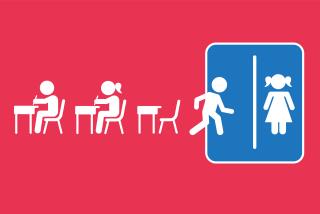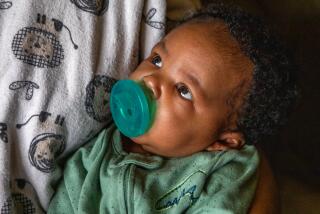Home ‘Baby-Proofing’ Can Reduce Risks : Safety: Doors, nooks and gadgets that are harmless in adult environs can be fatal attractions where toddlers roam.
- Share via
Marsha Bloom reached adulthood just fine, thank you, without drowning in an unlocked toilet.
“My husband is more paranoid than I--this was his idea,” the Laguna Hills mom said of her thoroughly baby-proofed home. “I figured that I didn’t grow up with all this stuff, and I managed to survive. But now I’m glad we did it. You can’t be too safe--babies are always one step ahead of you.”
Young urban parents may have removed the much-maligned “Baby On Board” signs from their Volvos, but today’s super-vigilant mothers and fathers still openly worry over Baby In House.
When their now 14-month-old son Austin took up crawling, Marsha and Stuart Bloom started to view their spacious two-story home as one big danger zone. So they summoned a professional: Gavin Behr of Kiddie Locks, a San Juan Capistrano-based business that specializes in “baby-proofing” cabinet doors, balcony rails and--oh, yes--toilet seat covers.
First off, Behr combs his clients’ houses in search of lurking perils. Innocent nooks and gadgets that are perfectly harmless in adult-only environs can become fatal attractions where toddlers roam.
“For example, most people leave their gas key in the keyhole beside the fireplace,” he said. “It should be put on the mantle. And a kid could choke on one of those white rubber caps on the springs behind doors.”
Balconies and stairways, Behr said, present the greatest risks--and ones that cannot just be placed out of a child’s reach.
He recommends attaching plexiglass sheets along the inside of balconies with rails wide enough for a baby’s head to squeeze through. The one-eighth-inch-thick plastic is relatively soft and flexible, so an inquisitive child cannot seriously harm himself by bumping his nose against it.
“Getting his head stuck between the rails or falling through would be a lot more dangerous than bruising his forehead on the plexiglass,” Behr added.
The nearly invisible panels require scant aesthetic sacrifice.
“We’ll probably leave the plexiglass in place until we decide whether to have a second child,” Marsha Bloom said. “I forget it’s even there.”
A wooden gate at the top of the Blooms’ stairway barricades little Austin from tumbling down. One side of the gate’s frame is nailed to the wall, while the other side is secured to a banister rail with sturdy twine.
“I don’t drill any holes in balcony rails,” Behr pledged. “Everything I do to the house can be easily reversed.” The plexiglass sheets, too, are tied rather than nailed to the balcony.
For the sake of convenience, the gate can be temporarily removed from its frame.
“We take it down for parties,” Bloom said.
Behr advised against the cheaper and more commonly used one-size-fits-all stretch gates, which are propped between forbidden doorways via pressure instead of nails or twine.
“A child can easily push one over,” he said.
Fences with crisscrosses that meet at the top in picketlike points are especially hazardous, Behr said: “The child can stick his feet into the gate’s triangles and climb it, and then get his clothing caught on one of the points.”
As an added precaution, Behr suggests that parents cover tile flooring at the foot of a stairway with a rug to soften a fall.
Kitchens and bathrooms harbor another potential for catastrophe, in the form of detergents, insecticides and medicines. Behr uses a spring-operated latch, manufactured by Gerber, which covertly fits inside drawers and cabinets. Springless plastic latches sold at supermarkets wear out in a matter of weeks, he warned.
Behr tells his clients that all kitchen and bathroom storage areas should be off-limits to children.
“Some of the ‘Mommy and Me’ classes advocate leaving a drawer or cabinet unlocked and putting toys in it, so that the kid can entertain himself while you’re cooking,” he said.
“I don’t believe in that. If the child knows there are toys in the bottom drawer, he thinks, well, there must be toys in the top drawer as well,” Behr said. “That will make him try all the harder to figure out how to open the other drawers.”
It’s not likely that a child would figure out the toilet seat latch Behr installs, whatever the incentive. The gadget is a bit disconcerting even to big folk.
“People have told me about parties where guests have come running out of the restroom saying, ‘I can’t open the toilet!’ ” Behr said. The latch can be temporarily retired for special occasions.
A toilet latch made by Mericon is Behr’s favorite because it clamps onto the lid rather than relying on double-sided tape.
In fact, he counsels, all “baby-proof” products that feature double-sided tape should be avoided, including locks and table-corner pads--the adhesive gives out sooner than later.
“This could come off with a mere tug,” Behr said, displaying an offender--a small table-corner cushion. “I would prefer that my kid bump his head on the table than choke on one of these.”
Sharp table edges can be mollified with none-too-appealing strips of foam rubber. But, Behr pointed out, “that’s really ugly and most people don’t want it.” He advises clients to cover ominous tables with thick cloth until Junior learns to negotiate furniture carefully.
When it comes to something so discreet as a bathroom fixture, however, Behr opts for functional over attractive.
“Which one of these would you buy?” he asked, holding up two bathtub faucet cushions.
One was irresistibly colorful and eye-catching: a firefighter sitting atop a fire hose, made of hard plastic. The other was a plain-wrap spout cover--by KinderGard--made of spongy foam.
“If something is cute, stay away from it,” Behr said.
Electrical socket covers come in the good, the bad and the ugly. The 12-for-$1.29 kind that simply plug in may just as simply be pulled out by a curious child.
As first choice, Behr recommends a child-proof socket lid on which off-center slits must be twisted upward for electrical contact. But unfortunately, the device does not accommodate all socket styles. So as second choice, he often uses a KinderGard plug more immovable than most.
All told, Behr emphasized, there’s no such thing as an entirely baby-safe home--regardless of the number of socket covers, gates, cabinet latches and plexiglass panels that have been installed.
“The purpose of these things is to give you a few extra seconds to catch up with the baby,” he said. “They are not a substitute for adult supervision.”
Gavin Behr, president of San Juan Capistrano-based Kiddie Locks, demonstrates the use of a safety device for electrical outlets.
More to Read
Sign up for Essential California
The most important California stories and recommendations in your inbox every morning.
You may occasionally receive promotional content from the Los Angeles Times.










